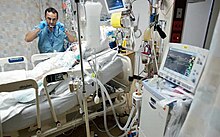Mechanical power

- For the physics concept, see Power (physics) § Mechanical power.
Mechanical power is a medical term which is a measure of the amount of energy imparted to a patient by a mechanical ventilator.[1][2][3][4][5]
While in many cases mechanical ventilation is a life-saving or life-preserving intervention, it also has the potential to cause harm to the patient via ventilator-associated lung injury. A number of stresses may be induced by the ventilator on the patient's lung. These include barotrauma caused by pressure, volutrauma caused by distension of the lungs, rheotrauma caused by fast-flowing delivery of gases and atelectotrauma resulting from repeated collapse and re-opening of the lung.
The purpose of mechanical power is to provide a quantity which can account for all of these stresses and therefore predict the amount of lung injury which is likely to be seen in the patient.
In patients who are ventilated in volume mode, it is calculated with the formula:
Power (J/min) = 0.098 x RR x Tv x (Ppeak – ½ x Paw) [where RR = respiratory rate, TV = tidal volume, Ppeak = peak pressure, Paw = mean airway pressure]
References[]
- ^ Gattinoni, L; Tonetti, T; Cressoni, M; Cadringher, P; Herrmann, P; Moerer, O; Protti, A (Oct 2016). "Ventilator-related causes of lung injury: the mechanical power". Intensive Care Med. 42 (10): 1567–1575. doi:10.1007/s00134-016-4505-2. PMID 27620287. S2CID 24768717.
- ^ Rahaman, U (2017). "Mathematics of Ventilator-induced Lung Injury". Indian J Crit Care Med. 21 (8): 521–524. doi:10.4103/ijccm.IJCCM_411_16. PMC 5588487. PMID 28904482.
- ^ Tonetti, T; Vasques, F; Rapetti, F; Maiolo, G; Collino, F; Romitti, F; Camporota, L (Jul 2017). "Driving pressure and mechanical power: new targets for VILI prevention". Ann Transl Med. 5 (14): 286. doi:10.21037/atm.2017.07.08. PMC 5537108. PMID 28828361.
- ^ Gattinoni, Luciano; Marini, John J.; Collino, Francesca; Maiolo, Giorgia; Rapetti, Francesca; Tonetti, Tommaso; Vasques, Francesco; Quintel, Michael (12 July 2017). "The future of mechanical ventilation: lessons from the present and the past". Critical Care. 21 (1): 183. doi:10.1186/s13054-017-1750-x. PMC 5508674. PMID 28701178.
- ^ Maia, LA; Samary, CS; Oliveira, MV; Santos, CL; Huhle, R; Capelozzi, VL (Oct 2017). "Impact of Different Ventilation Strategies on Driving Pressure, Mechanical Power, and Biological Markers During Open Abdominal Surgery in Rats". Anesth Analg. 125 (4): 1364–1374. doi:10.1213/ANE.0000000000002348. PMID 28759484. S2CID 8752045.
- Respiratory therapy
- Pulmonology
- Emergency medicine
- Medical equipment
- Intensive care medicine
- Lung disorders